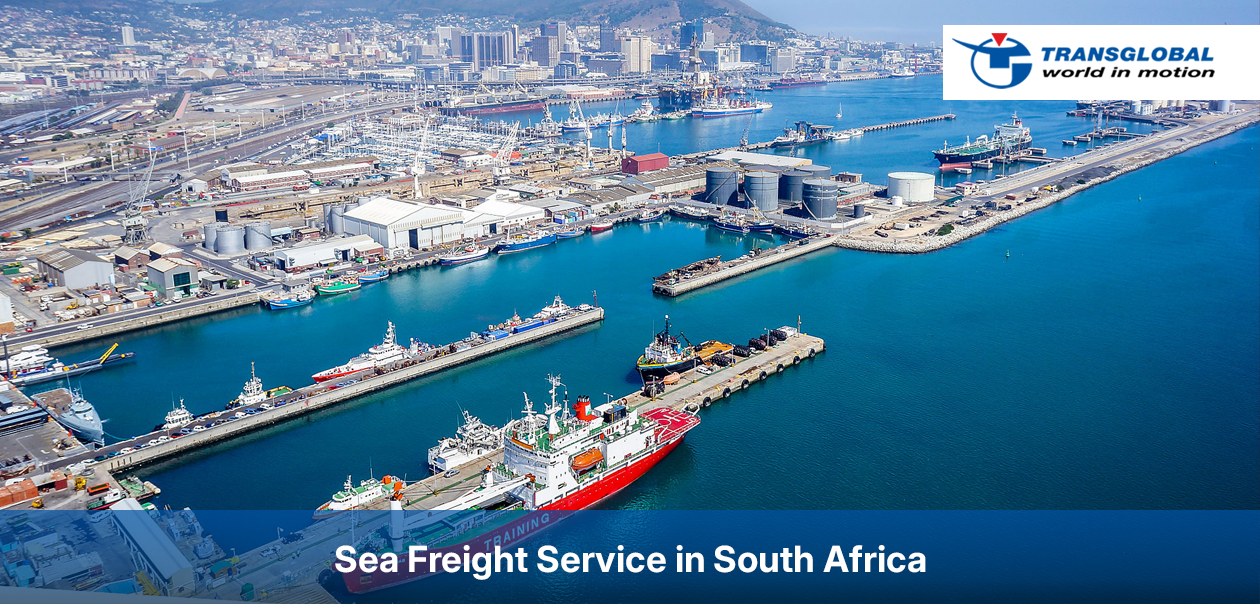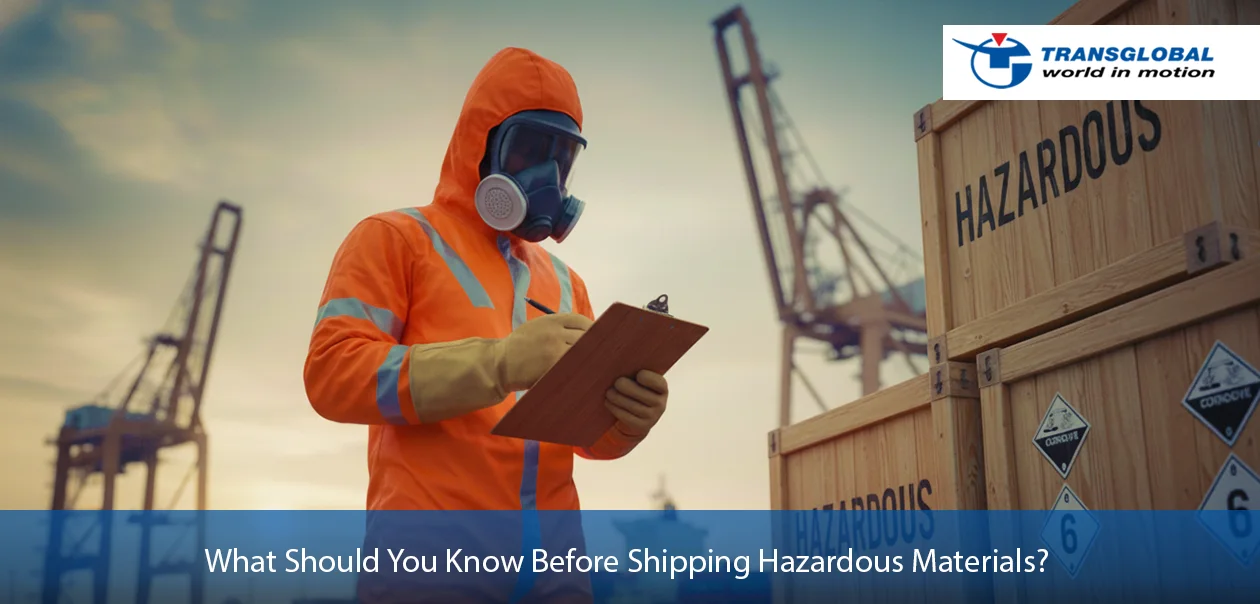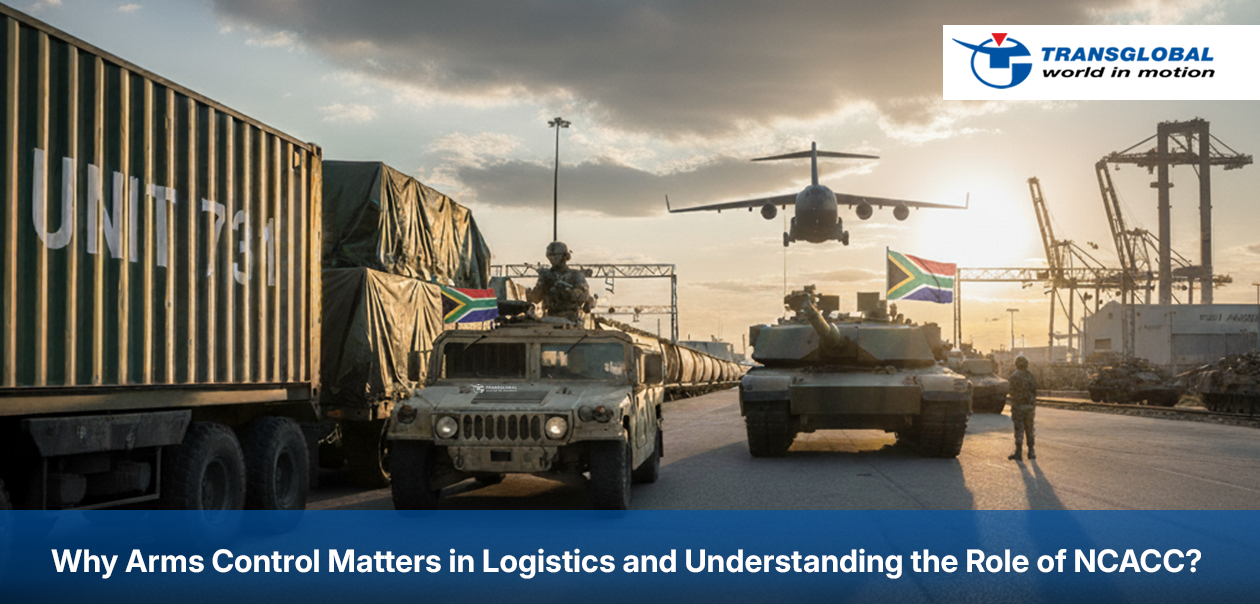South Africa’s trade lanes start and end on the water. Each year, millions of tons of minerals, fresh fruit, machinery, and consumer goods ride the waves and funnel through the container stacks at Durban, Cape Town, and Ngqura. If you ship regularly, you already know the rewards (bulk capacity, lower cost per kilogram) and the risks (weather, congestion, paperwork).
Sea freight service is still the most economical way to move large volumes across the globe, but only when you understand how the country’s ports tick and choose the right partner to keep cargo rolling.
Success on the ocean is determined by three factors: the vessel you book, the port you sail through, and the forwarder who coordinates the handoffs. Below, we examine each of the “big three” ports, break down the fundamental service kinds, and demonstrate how Transglobal Cargo maintains shipment schedules even when wind, rail strikes, or tides threaten to divert you.
What is Sea Freight and its Compliance?
Sea/Ocean freight is the movement of goods by ocean-going vessels, usually in 20- or 40-foot containers, but also as break-bulk, RoRo, or project cargo. Because it crosses international waters and multiple jurisdictions, every shipment must satisfy a web of safety, security, and trade regulations:
- IMO rules (SOLAS, IMDG, MARPOL) keep containers weighed, hazmat safe, and oceans clean.
- ISPS security plus intact seals protect boxes from theft and tampering.
- Customs accuracy, HS codes, manifests, SARS duties, fast clearance, and dodges penalties.
- Incoterms clarity defines who pays freight, insurance, and bears risk.
- Marine insurance & General Average shield you if the vessel suffers a casualty.
- A good forwarder stitches all five layers together and issues a clean, bank-ready bill of lading.
How does Sea Freight Work?
Quote & Booking
You request a rate. The forwarder compares FCL, LCL, or groupage options, and then books space with a carrier sailing on the right date.
Cargo Ready & Stuffing
Your supplier packs the container or delivers loose cartons to the consolidator’s depot. The forwarder verifies weights, seals the box, and cuts the export bill of lading.
Export Customs
A customs entry is lodged with SARS; once cleared, the container is trucked to the stack yard inside the port.
Port Operations
Port cranes load the box onto the vessel. You receive a vessel-on-board confirmation with the expected ETA at the destination port.
Ocean Transit
During the voyage, the forwarder monitors ETA changes, weather diversions, and trans-shipment connections. Updates feed into your tracking portal.
Import Customs
Pre-arrival data is filed; duties and VAT are paid (or the goods move into a bond). Customs may inspect the box, but correct HS codes and permits cut that risk.
Port Release & Last Mile
The container is discharged, moved through the terminal, and delivered to your warehouse. The forwarder returns the empty to the depot and closes out the file with proof of delivery.
Sea/Ocean – Freight Options
Why it matters: Transglobal’s ocean freight desk weighs transit time, sailing frequency, and port charges to recommend the cheapest option that still meets your deadline.
South Africa’s Three Main Container Gateways
Durban: Africa’s Heavyweight Hub
- Capacity & Growth: Durban Container Terminal (DCT) handles ≈ 3.6 million TEU a year, with berth-extension work underway to lift throughput to 4 million TEU (and longer-term plans to top 5 million).
- Seasonal Reality: Strong Indian-Ocean swells, high yard density, and equipment obstacles can still stretch berth waiting times to 6–9 days at Pier 2 in peak season.
- Transglobal’s Success: The company holds long-term slot agreements with all three global carrier alliances. When spot space dries up, Transglobal can still anchor your FCL or LCL booking, often at contract rates that beat the weekly market.
Cape Town: Cold-Chain Specialist
- Strength: Terminal staff is world-renowned for handling reefers, stone fruit, grapes, and citrus, making Cape Town the preferred gateway for South Africa’s fresh produce exports.
- Challenge: Summer south-easterly winds can halt crane operations, causing vessel delays that ripple through the cold chain.
- Transglobal’s Fix: The team tracks live wind alerts and locks premium reefer slots. If weather shuts the cranes, containers divert to Ngqura or roll onto conventional reefer vessels, keeping temperatures stable and avoiding costly truck-and-wait scenarios on the quay.
Ngqura (Coega): Deep-Water Up-and-Comer
- Depth & Design: With an -18 m entrance channel and a design capacity of 2 million TEU, Ngqura is South Africa’s deepest container port.
- Why Shippers Like It: Fewer vessels queue, congestion surcharges are lower, and the harbor can berth 15,000 TEU “Megamax” ships without tidal windows.
- Transglobal Advantage: A rail-and-road “port-switch” playbook moves Durban or Cape Town boxes to Ngqura overnight when those gateways clog, so your container still meets the intended mother vessel with no extra handling.
How Transglobal Keeps Containers Moving?
- Carrier alliances on tap – Pre-booked weekly slots mean you’re not scrambling for space when the market overheats.
- TransIT live tracking – Vessel ETAs, gate-moves, and PODs feed straight into your inbox or ERP, so buyers see real-time progress instead of chasing spreadsheets.
- Port-switch agility – If Durban is weather-bound, cargo rails to Ngqura and makes the same mother-vessel call; no double-handling, no extra storage.
- In-house specialists – From haz-chem drums to vintage cars, packaging, and permits are sorted without expensive third-party consultants.
- Transparent pricing – All-in quotes spell out ocean freight, bunker, THC, agency, and security; no “gotcha” surcharges when the invoice lands.
Booking Smart: Three Essentials to Nail Early
HS Code & Commodity Detail
A precise HS code keeps SARS valuations in check and side steps surprise duty or VAT reassessments at the wharf.
Incoterm & Ready Date
Clarify who pays for which move (e.g., FOB Durban or CPT Ngqura) and confirm the container’s “stack day.” Boxes that hit their stack window get lower ocean rates and avoid last-minute roll-overs.
Special-Handling Flags
Flag temperature needs, DG class, or out-of-gauge dimensions upfront. Your forwarder can then reserve flat-racks, reefers, or open-tops, book plug points, and arrange pre-trip inspections, avoiding costly on-quay rework.
Conclusion
Sea freight is the backbone of South African trade. When you pair deep local port knowledge with global carrier reach, it becomes a predictable, cost-efficient system for growth. Transglobal Cargo works every major gateway, Durban, Cape Town, and Ngqura, and keeps a close eye on the weather, yard density, and carrier schedules so your boxes don’t stall in a stackyard or miss their mother vessel.
Ready to tap into reliable ocean capacity and transparent, door-to-door service? Talk to Transglobal Cargo today. The team will map your lanes, compare FCL versus LCL costs, and build a sailing plan that keeps your supply chain running, whatever the ocean throws your way.
Frequently Asked Questions
How soon should I book the Durban space during the reefer peak?
Aim for 30 days in advance between October and February. Transglobal can grab last-minute slots, but early bookings lock in better rates and ensure plug-point availability.
Can Transglobal combine my small orders into one LCL every week?
Yes. Regular groupage services cut off mid-week, consolidating multiple suppliers into shared containers so you avoid paying for half-empty boxes.
What if my container is pulled for SARS inspection?
Transglobal shifts the box to its bonded depot, unpacks under customs supervision, repacks, and fast-tracks release. AEO-level paperwork keeps inspection frequency low, and any extra costs are flagged before work begins.





Comments